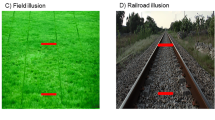Abstract
Glass patterns (GPs) are static stimuli that consist of randomly positioned dot-pairs that are spatially integrated to create the perception of a global form. However, when multiple independently generated static GPs are presented sequentially (termed ‘dynamic’ GP), observers report a percept of coherent motion, and data show an improvement in sensitivity. This increased sensitivity has been attributed to a summation of the form signals provided by the individual GPs. In Experiment 1, we tested whether pigeons also show a heightened sensitivity to dynamic GPs. Our results show that pigeons are significantly better at learning to discriminate dynamic GPs from noise compared with static GPs. However, in contrast to previous research, we found that pigeons did not perform well enough with our static GPs to extract sensitivity measurements. In Experiment 2, we compared our static GPs to those that have been used previously. We show that the difference in the comparison noise patterns is important. We used dipole noise patterns, while previous studies used uniform noise patterns that differ in mean dot spacing to the S+. We argue that prior findings from the use of GPs in pigeons should be re-evaluated using dynamic GP stimuli with noise that consist of dipoles.





Similar content being viewed by others
References
Anderson SJ, Swettenham JB (2006) Neuroimaging in human amblyopia. Strabismus 14:21–35
Bischof WF, Reid SL, Wylie DR, Spetch ML (1999) Perception of coherent motion in random dot displays by pigeons and humans. Percept Psychophys 61:1089–1101
Burr DC, Ross J (2006) The effects of opposite-polarity dipoles on the detection of Glass patterns. Vis Res 46:1139–1144
Cavoto KK, Cook RG (2001) Cognitive precedence for local information in hierarchical stimulus processing by pigeons. J Exp Psychol Anim B 27:3–16
Cavoto BR, Cook RG (2006) The contribution of monocular depth cues to scene perception by pigeons. Psychol Sci 17:628–634
Cook RG (2000) The comparative psychology of avian visual cognition. Curr Dir Psychol Sci 9:83–88
Cook RG (2001) Hierarchical stimulus processing in pigeons. In: Cook RG (ed) Avian visual cognition. http://www.pigeon.psy.tufts.edu/avc/cook/
Dakin SC, Bex PJ (2002) Summation of concentric orientation structure: seeing the Glass or the window? Vis Res 42:2013–2020
Day AM, Palomares M (2014) How temporal frequency affects global form coherence in Glass patterns. Vis Res 95:18–22
Feczko E, Shulman GL, Petersen SE, Pruett JR (2014) Interactions between concentric form-from-structure and face perception revealed by visual masking but not adaptation. J Vis 14:5
Fowler J, Cohen L (1990) Practical statistics for field biology. Wiley, England
Franconeri SL, Simons DJ (2003) Moving and looming stimuli capture attention. Percept Psychophys 65:999–1010
Fremouw T, Herbranson WT, Shimp CP (2002) Dynamic shifts of pigeon local/global attention. Anim Cognit 5:233–243
Geisler WS (1999) Motion streaks provide a spatial code for motion direction. Nature 400:65–69
Glass L (1969) Moiré effect from random dots. Nature 223:578–580
Hodos W (2012) What Birds See and What They Don’t: Luminance, contrast, and spatial and temporal resolution. In: Lazareva OF, Shimizu T, Wasserman EA (eds) How animals see the world: comparative behavior, biology, and evolution of vision. Oxford University Press, London, pp 5–25
Kelly DM, Bischof WF, Wong-Wylie DR, Spetch ML (2001) Detection of glass patterns by pigeons and humans: implications for differences in higher-level processing. Psychol Sci 12:338–342
Lazareva OF, Shimizu T, Wasserman EA (2012) How animals see the world: Behavior, biology, and evolution of vision. Oxford University Press, London
Nankoo J-F, Madan CR, Spetch ML, Wylie DR (2012) Perception of dynamic Glass patterns. Vis Res 72:55–62
Nankoo J-F, Madan CR, Spetch ML, Wylie DR (2014) Perception of complex motion in humans and pigeons (Columba livia). Exp Brain Res 232:1843–1853
Nankoo J-F, Madan CR, Spetch ML, Wylie DR (2015) Temporal summation of global form signals in dynamic Glass patterns. Vis Res 107:30–35
Or CC-F, Khuu SK, Hayes A (2007) The role of luminance contrast in the detection of global structure in static and dynamic, same- and opposite polarity, Glass patterns. Vis Res 47:253–259
Qadri MA, Cook RG (2014) The perception of Glass patterns by starlings (Sturnus vulgaris). Psychon B Rev. doi:10.3758/s13423-014-0709-z
Riesenhuber M, Poggio T (1999) Hierarchical models of object recognition in cortex. Nat Neurosci 2:1019–1025
Riesenhuber M, Poggio T (2000) Models of object recognition. Nat Neurosci 3:1199–1204
Ross J, Badcock DR, Hayes A (2000) Coherent global motion in the absence of coherent velocity signals. Curr Biol 10:679–682
Smith M, Kohn A (2007) Glass pattern responses in macaque V2 neurons. J Vis 7:1–15
Smith MA, Bair W, Movshon JA (2002) Signals in macaque striate cortical neurons that support the perception of glass patterns. J Neurosci 22:8334–8345
Wilson HR, Wilkinson F (1998) Detection of global structure in Glass patterns: Implications for form vision. Vis Res 38:2933–2947
Wilson HR, Wilkinson F, Asaad W (1997) Concentric orientation summation in human form vision. Vis Res 37:2325–2330
Acknowledgments
This research was supported by grants from the National Science and Engineering Research Council (NSERC) of Canada to M.L.S. and D.R.W., and by an NSERC Alexander Graham Bell Canada Graduate Scholarship (Doctoral-level) to C.R.M. All research was conducted in accordance with Canadian Council on Animal Care guidelines and with approval from the University of Alberta Animal Welfare Policy Committee.
Author information
Authors and Affiliations
Corresponding author
Electronic supplementary material
Below is the link to the electronic supplementary material.
Rights and permissions
About this article
Cite this article
Nankoo, JF., Madan, C.R., Wylie, D.R. et al. Re-evaluating birds’ ability to detect Glass patterns. Anim Cogn 18, 945–952 (2015). https://doi.org/10.1007/s10071-015-0865-1
Received:
Revised:
Accepted:
Published:
Issue Date:
DOI: https://doi.org/10.1007/s10071-015-0865-1




